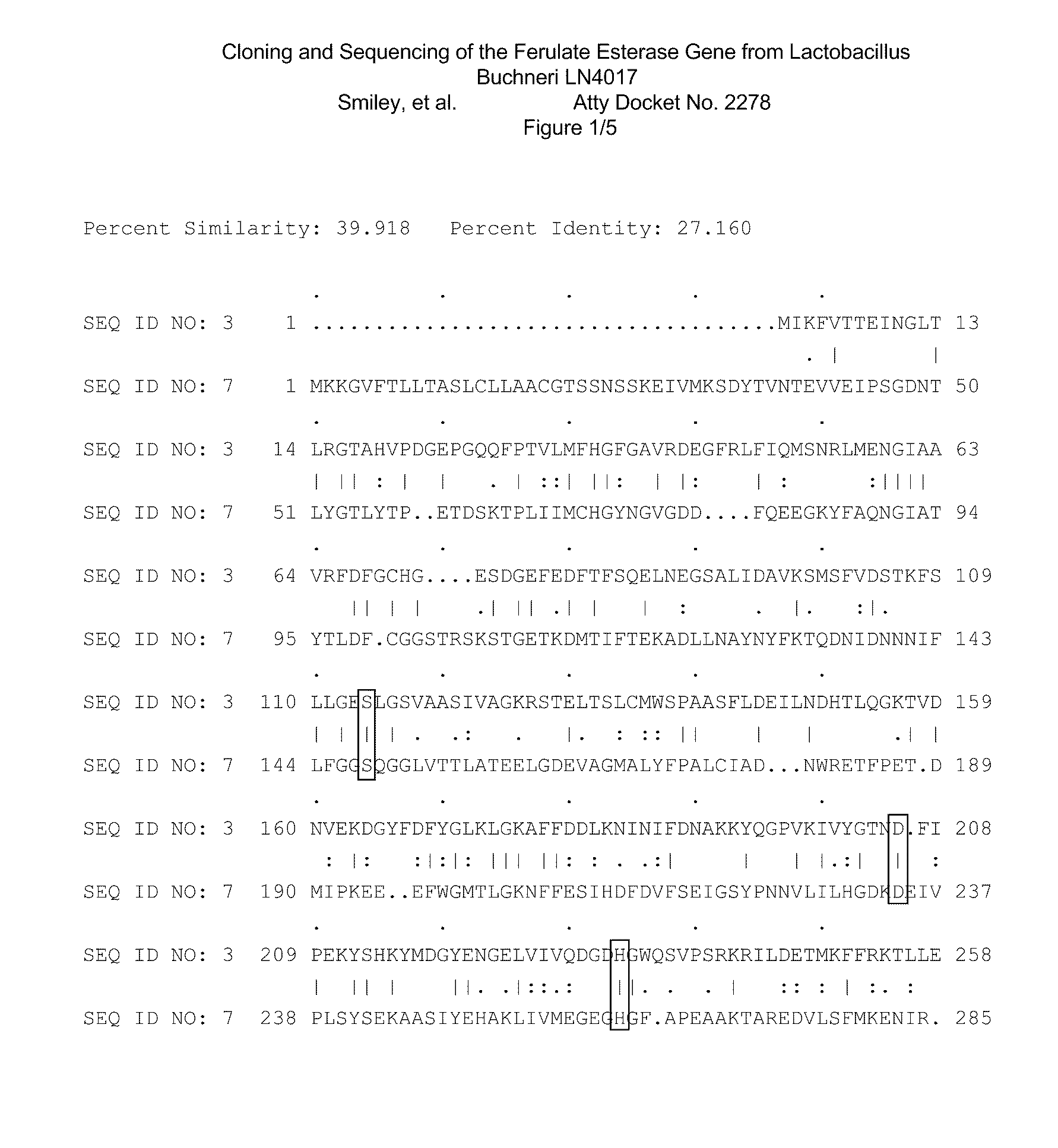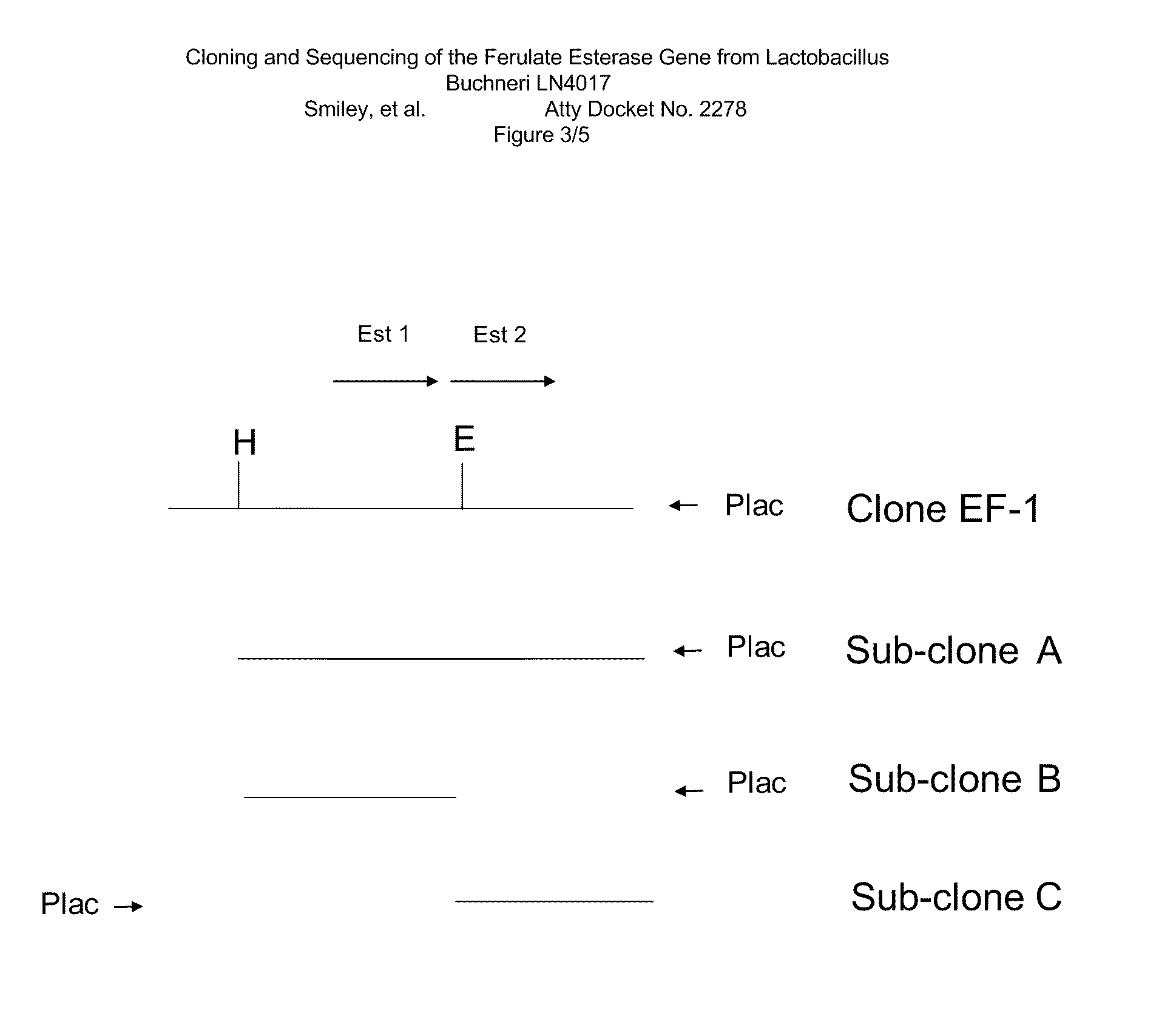Cloning and sequencing of the ferulate esterase gene from Lactobacillus buchneri LN4017
a technology of esterase and lactobacillus, which is applied in the field of polypeptides having feru, can solve the problems of limiting the profitability of farmers, unable to meet the demands of modern animal production, and the cell wall of plants to digest, so as to increase the digestibility of plants
- Summary
- Abstract
- Description
- Claims
- Application Information
AI Technical Summary
Benefits of technology
Problems solved by technology
Method used
Image
Examples
example 1
Ferulate Esterase Gene Cloning
[0115]Total DNA from Lactobacillus buchneri strain LN4017, deposited as Patent Deposit No. PTA-6138, was used to generate an E. coli clone which expressed FE activity. Size-fractionated partial Sau3AI digested total DNA libraries of LN4017 were constructed. Approximately 1000 clones were screened for FE activity in E. coli DH5alpha by looking for zones of clearing on Difco™ Luria-Bertani agar plates containing 50 μg / mL Ampicillin, 80 μM IPTG and 0.12% ethyl 4-hydroxy-3-methoxycinnamate. One FE positive clone was identified and found to contain a 3 kb insert in pUC18. The plasmid DNA was transformed into E. coli Novablue cells and a number of transformants were generated including clone EF-1. This clone also showed zones of clearing on agar plates.
[0116]The 3 kb EF-1 clone was cut into smaller fragments with convenient restriction enzymes and sub-cloned into pUC18, using DH5alpha as the cloning host. Removal of a 0.45 kb fragment from one end generated s...
example 2
Ferulate Esterase Gene Sequence Analysis
[0117]DNA sequencing was conducted on clone EF-1 and on sub-clones A, B and C. Sequence analysis of an ORF (SEQ ID NO: 2) from sub-clone B indicated that it encoded a peptide (SEQ ID NO: 3) of 260 amino acids with a 28 kDa molecular weight. BLASTX analysis of SEQ ID NO: 2 detected a number of amino acid homologies including homology to alpha / beta hydrolases (including Accession Nos: AAK81587, AAM25001), Lactobacillus esterases (including Accession Nos: AAV43644, CAD65143) and cinnamoyl ester hydrolases (including Accession No: ZP—00732443). Esterase active site residues appeared to be conserved.
[0118]Sub-clone C was resistant to sequencing on one end, possibly due to secondary structure within the DNA. Multiple primers from both directions were attempted. The region was ultimately sequenced using DNA from the 3 kb clone EF-1 and sub-clone A and the resulting ORF is set forth herein as SEQ ID NO: 4, which encodes SEQ ID NO: 5. BlastX analysis o...
example 3
Ferulate Esterase and Acetyl Esterase Activity Assays
[0121]The FE and AE activities of the 3 kb clone, EF-1 (discussed in Example 1), and of sub-clones A, B and C, were assayed according to the protocols described below. As shown in Table 1, cell lysates from clone EF-1 (which contains the ORFs for the peptides of SEQ ID NOs: 3 and 5) and sub-clone A (which is missing an upstream non-coding region) had strong FE and AE activity. Sub-clone B (which contains the ORF for the peptide of SEQ ID NO: 3) had FE activity but lacked AE activity, relative to the vector-only control. Sub-clone C (which encodes a smaller portion of the peptide of SEQ ID NO: 5) had neither AE activity nor FE activity, relative to the vector-only control. This data suggests that the peptide of SEQ ID NO: 3 is an FE enzyme, while the peptide of SEQ ID NO: 5 is an AE enzyme.
[0122]
TABLE 1Activity Levels of Cleared Lysates. Activity isexpressed as nmoles pNP released / min / mg protein.SampleDetails1FE2AE3pUC18vector only...
PUM
| Property | Measurement | Unit |
|---|---|---|
| temperature | aaaaa | aaaaa |
| temperature | aaaaa | aaaaa |
| pH | aaaaa | aaaaa |
Abstract
Description
Claims
Application Information
 Login to View More
Login to View More - R&D
- Intellectual Property
- Life Sciences
- Materials
- Tech Scout
- Unparalleled Data Quality
- Higher Quality Content
- 60% Fewer Hallucinations
Browse by: Latest US Patents, China's latest patents, Technical Efficacy Thesaurus, Application Domain, Technology Topic, Popular Technical Reports.
© 2025 PatSnap. All rights reserved.Legal|Privacy policy|Modern Slavery Act Transparency Statement|Sitemap|About US| Contact US: help@patsnap.com



